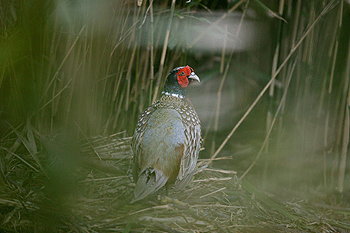On your shoot: Wandering birds

Our birds have done rather well this year. We had a decent summer, a fairly trouble-free release period, no major predation problems and the amount of dogging-in we’ve been doing has been nothing out of the ordinary. Everything was ticking along quite nicely until the beginning of October, when they went off their food and did a vanishing act.
Seeing birds that aren’t eating much is okay. Putting a lot of food out, having it vanish and not seeing the birds is okay as well. But not seeing the birds when the food is not being eaten can make even the best of us a little twitchy. No matter how experienced you are, you can’t help wondering if you’ve still got your birds.
The problem is that this year there has been a bumper crop of just about everything, and as soon as the birds could get at it they started to ignore the wheat put out for them. Pheasants do extremely well on wild food, but it makes it difficult when we’re trying to concentrate them in the drives. It can extend the dogging-in period by at least a month.
As well as dogging-in, we’ve been adding a bit of variety to their diet, trying to keep them amused and making the woods and gamecrops as attractive to pheasants as possible. If they don’t want our food because there are plenty of alternatives, they might want to hang about for other reasons instead.
Flatten rows and swipe rides
Where we have maize as a gamecrop, we have flattened the odd row with the quad bikes, so the birds can get at the cobs. If the cobs are too high for them to reach they will walk right through a gamecrop without knowing what’s above their heads. We started doing this when most of our cobs were still green and a few weeks from ripening, but the birds picked at them just the same. Having maize cobs to pick at gives the birds something to do and keeps them where you want them. It also concentrates the birds on the rows that have been flattened, which helps give you an idea of the number in the crop.
In the kale crops we’ve swiped rides in long sweeping “S” shapes rather than in straight rows from one side to the other. The beauty of an “S”-shaped ride is that it doesn’t let the wind whistle through like a long straight one does, and it tends to slow the birds down a bit when they’re walking up it. This means they don’t just use the ride as a way of getting out of the crop and on to the fields on the other side.
Cutting rides in kale also gets the birds into the crop, so they’re not just standing on the edges. Kale growing on the edges of a crop will bush-up and form a wall of cover almost down to the ground, which the birds won’t want to push into, whereas kale growing in rows in the middle of a crop will be tall and straight with only the top growth on the stalks. The bare stems and leafy canopy make it ideal habitat for pheasants because they can walk about in it and feel safe at the same time, but they will only use it once they know it’s there — swiping a few rides is the quickest way of showing them.
This year the trees are holding on to their leaves, which is making the woods a bit dark and gloomy — and dark and gloomy woods aren’t the least bit attractive to pheasants. Keeping the rides trimmed and as wide as possible helps to let the light in, but most of our birds are still on the woodland edges and not in the middle of the woods, where they will be later on in the season when there’s more light and they need to shelter from the wind.
We place our hoppers either on the edges of the wood or just inside for this reason. If we put them where we’re going to want them once the leaf is off and the birds haven’t pulled in, nothing’s going to use them.
The same goes for trail feeding. While the birds are off the feed, we’re still trail feeding, but only lightly, in the places where the birds have been clearing it up. If we put too much out or feed the main rides before the birds are feeding properly, it will just stay on the ground where it’s either going to get eaten by vermin or start growing.
Attractive additions
In an attempt to make the food we’re putting out more attractive (though it’s never going to be as attractive as a carpet of acorns in the eyes of a pheasant), we have been adding a bit of chopped maize to the wheat. The chopped maize seems to pull them in a bit, but it is a lot more expensive so we’ll probably stop using it once the pheasants are back on the feed. I have tried the specialist seed mixes but they weren’t any better, and because they cost even more we’ve stuck with the chopped maize.
Swiping rides, flattening maize, making the woods more attractive and adding something to the feed will all help pull the birds back into the drives, but none of these measures are going to be as effective as a change in the weather. A few hard frosts and some high winds will pull them back in quicker than we ever can, but as we don’t have any control over the weather (and could end up having a mild winter) I’m just going to keep my fingers crossed, carry on doing what I can and hope the pheasants are still there.








